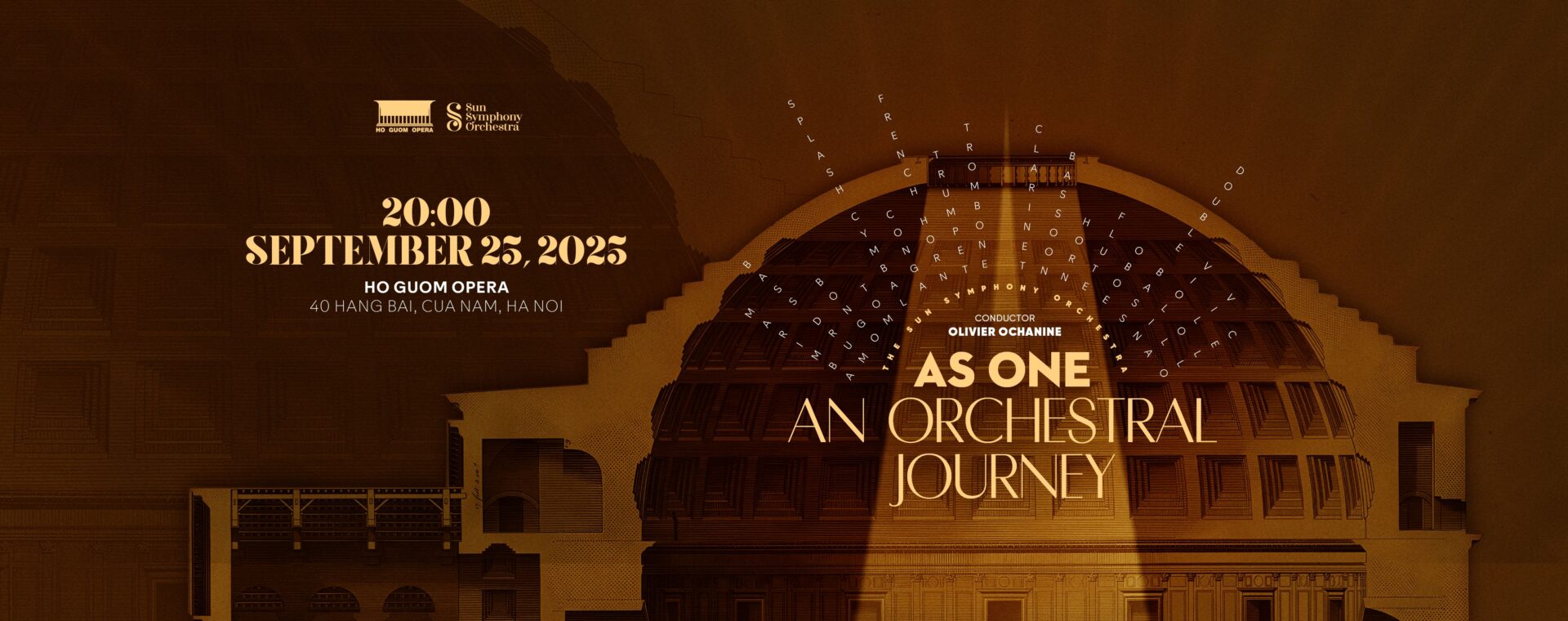Short description
As One: An Orchestral Journey – when instrument families share one roof
Gene Koshinski
As One [Percussion]
Jacques Ibert
Trois pièces brèves (wind quintet)
Victor Ewald
Brass Quintet No. 1
Ottorino Respighi
Ancient Airs and Dances Suite No. 3
Mendelssohn
Symphony No. 4 “Italian”
“As One: An Orchestral Journey” – when instrument families share one roof
In English, each orchestra section is called an instrument family. Like our own families, each has its own personality, the energetic percussion, graceful woodwinds, supple strings, and powerful brass, all united under the Sun Symphony Orchestra.
On September 25, 2025, Music Director Olivier Ochanine invites you to meet these families one by one through vibrant miniatures, before they join forces in Mendelssohn’s Symphony No. 4 “Italian” – a radiant portrait of Mediterranean sun, festivals, and community spirit.
No need to “understand music”, just bring your ears and curiosity. More than a concert, this is a festival of unity, where individuals shine before blending into a greater whole. And who knows—you may leave having found your favorite new “family member” in the SSO.
As One – Gene Koshinski
Opening As One: An Orchestral Journey is a piece that is both unusual and dramatic: Gene Koshinski’s As One. Two percussionists stand face-to-face, sharing a five-octave marimba and identical setups of bass drum, toms, bongos, congas, and splash cymbals. Working “as one,” they weave intricate hocketed rhythms, creating a powerful, precise, and gripping musical dialogue.
Praised by PBS for his “jaw-dropping virtuosity and a flair for the unexpected,” Gene Koshinski (b. 1980) has dazzled audiences worldwide with his versatility as a soloist, chamber musician, symphonic player, jazz and pop artist, and composer. Currently Professor of Percussion at the University of Delaware, his works have been performed in more than 40 countries, including at prestigious institutions such as Juilliard, the Royal College of Music, and the Conservatoire de Lyon. With a career that bridges performance and composition on the international stage, Koshinski stands among the most distinctive voices in contemporary percussion.
Trois pièces brèves – Jacques Ibert
Following the percussion’s striking opening, the woodwinds take center stage with great wit and charm in Jacques Ibert’s Trois pièces brèves (“Three Short Pieces”). This work, written for a wind quintet and with a duration of only 6–7 minutes, achieves the remarkable feat of composing three miniatures that are distinct in character and mood: a buoyant and playful frolic, a humorous and vigorous ditty, and finally a gentle and lyrical lullaby, clearly revealing the full expressive range of the woodwinds.
French composer Jacques Ibert (1890-1962) was known for his unusual stylistic assortment. Rather than being within a single school of thought, his music is imaginative and full of life. Trois pièces brève illustrates his point beautifully: the woodwinds come forth as players in discussions characterized— at times, humorous and at moments, sentimental, and always captivating.
Brass Quintet No. 1 – Victor Ewald
After the charm of the woodwinds, the brass take the stage with resplendent power in Victor Ewald’s Brass Quintet No. 1. Considered one of the very first masterpieces written specifically for brass quintet, this work is a landmark in the genre. Its music balances grandeur and nobility with surprising tenderness, allowing the brass to shine not only in brilliance but also in warmth and lyricism.
Remarkably, Victor Vladimirovich Ewald (1860–1935) was not only a composer but also a Russian civil engineer and architect. His life embodied the duality of science and art, yet his legacy lies in the brass quintets that remain staples of the chamber repertoire today. Infused with Russian spirit, his music reflects both strength and humanity.
Ancient Airs and Dances Suite No. 3 – Ottorino Respighi
With a flourish from the brass, the strings transport us to a soundscape both ancient and new in Ottorino Respighi’s Ancient Airs and Dances Suite No. 3. Drawing on Renaissance and Baroque songs and dances, Respighi reimagines these melodies with lush orchestrations, creating music that is at once elegant, poetic, and cinematic.
What sets Suite No. 3 apart is its scoring for string orchestra, which lends the work a refined, intimate, and deeply expressive character. Each movement feels like a glimpse into the past – sometimes graceful, sometimes dreamlike, sometimes bursting with vitality – weaving together history and modernity in a seamless tapestry.
Ottorino Respighi (1879–1936) was one of Italy’s foremost 20th-century composers, celebrated for his masterful orchestration and fascination with early music. His three Ancient Airs and Dances suites stand as luminous examples of his artistry, reviving centuries-old sounds through a contemporary lens.
Symphony No. 4 “Italian” – Felix Mendelssohn
Closing the journey of As One: An Orchestral Journey is the dazzling Symphony No. 4 “Italian” by Felix Mendelssohn. Inspired by his travels through Italy in the 1830s, the work radiates sunshine, pilgrim footsteps, and exuberant folk dances. Mendelssohn once wrote to his father: “This is Italy! And now has begun what I have always thought to be the supreme joy in life.” That joy shines through every bar of this symphony.
Felix Mendelssohn (1809–1847), the German prodigy who rose to fame as a teenager, was not only a masterful composer but also a brilliant conductor, pianist, and violinist. The Italian Symphony is among his most radiant creations, a musical portrait of Italy painted with Romantic vitality and charm.
And here’s the twist: in this final piece, the conductor will “disappear” – leaving the orchestra on its own. But where will the maestro turn up? Who will use the baton? That’s for you to discover on the concert night.
